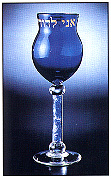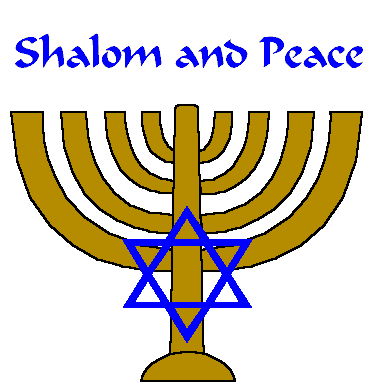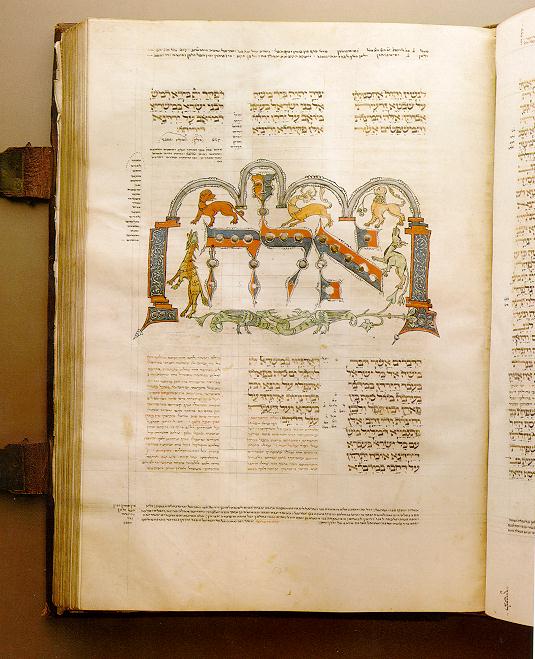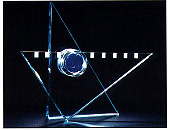|
|
|
 |
Jewish Holidays |  |
|
Holidays |
|
 |
When Holidays Begin All Jewish holidays begin the evening before the date specified. This is because a Jewish "day" begins and ends at sunset, rather than at midnight. If you read the story of creation in Genesis Ch. 1, you will notice that it says, "And there was evening, and there was morning, one day." From this, we infer that a day begins with evening, that is, sunset. For the precise time when a holiday begins in your area, consult the list of candle lighting times provided by the Orthodox Union or any Jewish calendar. |
| Work on Holidays Work is not permitted on Rosh Hashanah, Yom Kippur, the first and second days of Sukkot, Shemini Atzeret, Simkhat Torah, Shavu'ot, and the first, second, seventh and eighth days of Passover. The "work" prohibited on those holidays is the same as that prohibited on Shabbat, except that cooking, baking, transferring fire and carrying, all of which are forbidden on Shabbat, are permitted on holidays. When a holiday occurs on Shabbat, the full Shabbat restrictions are observed. |
 |
 |
Extra Day of Holidays You may notice that the number of days of some holidays do not accord with what the Bible specifies. In most cases, we celebrate one more day than the Bible requires. There is an interesting reason for this additional day. The Jewish calendar is lunar, with each month beginning on the new moon. The new months used to be determined by observation. When the new moon was observed, the Sanhedrin declared the beginning of a new month notice sent out messengers to tell people when the month began. People in distant communities could not always be notified of the new moon (and therefore, of the first day of the month), so they did not know the correct day to celebrate. They knew that the old month would be either 29 or 30 days, so if they didn't get notice of the new moon, they celebrated holidays on both possible days. This practice of celebrating an extra day was maintained as a custom even after we adopted a precise mathematical calendar, because it was the custom of our ancestors. This extra day is not celebrated by Israelis, regardless of whether they are in Israel at the time of the holiday, because it is not the custom of their ancestors, but is celebrated by everybody else, even if they are visiting Israel at the time of the holiday. Rosh Hashanah is celebrated as two days everywhere (in Israel and outside Israel), because it occurs on the first day of a month. Messengers were not dispatched on the holiday, so even people in Israel did not know whether a new moon had been observed, and everybody celebrated two days. The practice was also maintained as a custom after the mathematical calendar was adopted. Yom Kippur is celebrated only one day everywhere, because extending the holiday's severe restrictions for a second day would cause an undue hardship. |
| Description of the Holidays ROSH HASHANAH is commonly known as the Jewish New Year.Rosh Hashanah occurs on the first and second days of Tishri.The Jewish New Year is a time to begin introspection, looking back at the mistakes of the past year and planning the changes to make in the new year. DAYS OF OWE is a time for serious introspection, a time to consider the sins of the previous year and repent before Yom Kippur. The ten days starting with Rosh Hashanah and ending with Yom Kippur are commonly known as the Days of Awe (Yamim Noraim) or the Days of Repentance. Among the customs of this time, it is common to seek reconciliation with people you may have wronged during the course of the year. YOM KIPPUR is probably the most important holiday of the Jewish year.Many Jews who do not observe any other Jewish custom will refrain from work, fast and/or attend synagogue services on this day. Yom Kippur occurs on the 10th day of Tishri. The holiday is instituted at Leviticus 23:26 et seq. The name "Yom Kippur" means "Day of Atonement," and that pretty much explains what the holiday is. It is a day set aside to "afflict the soul," to atone for the sins of the past year. In Days of Awe, I mentioned the "books" in which G-d inscribes all of our names. On Yom Kippur, the judgment entered in these books is sealed. This day is, essentially, your last appeal, your last chance to change the judgment, to demonstrate your repentance and make amends. |
 |
 |
Description of Holidays SUKKOT The Festival of Sukkot begins on Tishri 15, the fifth day after Yom Kippur. It is quite a drastic transition, from one of the most solemn holidays in our year to one of the most joyous. This festival is sometimes referred to as Zeman Simkhateinu, the Season of our Rejoicing. Sukkot lasts for seven days. The two days following the festival are separate holidays, Shemini Atzeret and Simkhat Torah, but are commonly thought of as part of Sukkot. The word "Sukkot" means "booths," and refers to the temporary dwellings that we are commanded to live in during this holiday. The name of the holiday is frequently translated "The Feast of Tabernacles," which, like many translations of technical Jewish terms, isn't terribly useful unless you already know what the term is referring to. The Hebrew pronunciation of Sukkot is "Sue COAT," but is often pronounced as in Yiddish, to rhyme with "BOOK us." Like Passover and Shavu'ot, Sukkot has a dual significance: historical and agricultural. The holiday commemorates the forty-year period during which the children of Israel were wandering in the desert, living in temporary shelters. Sukkot is also a harvest festival, and is sometimes referred to as Chag Ha-Asif, the Festival of Ingathering. |
| More Holidays PURIM commemorates a time when the Jewish people living in Persia were saved from extermination. The story of Purim is told in the Biblical book of Esther. The heroes of the story are Esther, a beautiful young Jewish woman living in Persia, and her cousin Mordecai, who raised her as if she were his daughter. Esther was taken to the house of Ahasuerus, King of Persia, to become part of his harem. King Ahasuerus loved Esther more than his other women and made Esther queen, but the king did not know that Esther was a Jew, because Mordecai told her not to reveal her nationality. The villain of the story is Haman, an arrogant, egotistical advisor to the king. Haman hated Mordecai because Mordecai refused to bow down to Haman, so Haman plotted to destroy the Jewish people. In a speech that is all too familiar to Jews, Haman told the king, "There is a certain people scattered abroad and dispersed among the peoples in all the provinces of your realm. Their laws are different from those of every other people's, and they do not observe the king's laws; therefore it is not befitting the king to tolerate them." Esther 3:8. The king gave the fate of the Jewish people to Haman, to do as he pleased to them. Haman planned to exterminate all of the Jews. Mordecai persuaded Esther to speak to the king on behalf of the Jewish people. This was a dangerous thing for Esther to do, because anyone who came into the king's presence without being summoned could be put to death, and she had not been summoned. Esther fasted for three days to prepare herself, then went into the king. He welcomed her. Later, she told him of Haman's plot against her people. The Jewish people were saved, and Haman was hanged on the gallows that had been prepared for Mordecai. |
 |
 |
Channukah CHANNUKAH is the Jewish festival of rededication, also known as the festival of lights, is an eight day festival beginning on the 25th day of the Jewish month of Kislev. Chanukkah is probably one of the best known Jewish holidays, not because of any great religious significance, but because of its proximity to Christmas. Many non-Jews (and even many assimilated Jews!) think of this holiday as the Jewish Christmas, adopting many of the Christmas customs, such as elaborate gift-giving and decoration. It is bitterly ironic that this holiday, which has its roots in a revolution against assimilation and the suppression of Jewish religion, has become the most assimilated, secular holiday on our calendar. |
| PESACH : PASSOVER PESACH : PASSOVER Pesach is the one most commonly observed, even by otherwise non-observant Jews. According to the 1990 National Jewish Population Survey (NJPS), more than 80% of Jews have attended a Pesach seder. Pesach begins on the 15th day of the Jewish month of Nissan. It is the first of the three major festivals with both historical and agricultural significance (the other two are Shavu'ot and Sukkot). Agriculturally, it represents the beginning of the harvest season in Israel, but little attention is paid to this aspect of the holiday. The primary observances of Pesach are related to the Exodus from Egypt after generations of slavery. This story is told in Exodus, Ch. 1-15. Many of the Pesach observances are instituted in Chs. 12-15. The name "Pesach" (PAY-sahch, with a "ch" as in the Scottich "loch") comes from the Hebrew root Peh-Samech-Chet meaning to pass through, to pass over, to exempt or to spare. It refers to the fact that G-d "passed over" the houses of the Jews when he was slaying the firstborn of Egypt. In English, the holiday is known as Passover. "Pesach" is also the name of the sacrificial offering (a lamb) that was made in the Temple on this holiday. The holiday is also referred to as Chag he-Aviv (the Spring Festival), Chag ha-Matzoth (the Festival of Matzahs), and Z'man Cherutenu (the Time of Our Freedom) (again, all with those Scottish "ch"s). Probably the most significant observance related to Pesach involves the removal of chametz (leaven; sounds like "hum it's" with that Scottish ch) from our homes. This commemorates the fact that the Jews leaving Egypt were in a hurry, and did not have time to let their bread rise. It is also a symbolic way of removing the "puffiness" (arrogance, pride) from our souls. Chametz includes anything made from the five major grains (wheat, rye, barley, oats and spelt) that has not been completely cooked within 18 minutes after coming into contact with water. Orthodox Jews of Ashkenazic background also avoid rice, corn, peanuts, and legumes (beans) as if they were chametz. All of these items are commonly used to make bread, thus use of them was prohibited to avoid any confusion. Such additional items are referred to as "kitniyot." We may not eat chametz during Pesach; we may not even own it or derive benefit from it. We may not even feed it to our pets or cattle. All chametz, including utensils used to cook chametz, must either be disposed of or sold to a non-Jew (they can be repurchased after the holiday). Pets' diets must be changed for the holiday, or the pets must be sold to a non-Jew (like the food and utensils, the pets can be repurchased after the holiday ends). You can sell your chametz online at http://www.chabadcenter.org/. I have noticed that many non-Jews and non-observant Jews mock this practice of selling chametz as an artificial technicality. I assure you that this sale is very real and legally binding, and would not be valid under Jewish law if it were not. From the gentile's perspective, the purchase functions much like the buying and selling of futures on the stock market: even though he does not take physical posession of the goods, his temporary legal ownership of those goods is very real and potentially profitable. The process of cleaning the home of all chametz in preparation for Pesach is an enormous task. To do it right, you must prepare for several weeks and spend several days scrubbing everything down, going over the edges of your stove and fridge with a toothpick and a Q-Tip, covering all surfaces that come in contact with foil or shelf-liner, etc., etc., etc. After the cleaning is completed, the morning before the seder, a formal search of the house for chametz is undertaken, and any remaining chametz is burned. The grain product we eat during Pesach is called matzah. Matzah is unleavened bread, made simply from flour and water and cooked very quickly. This is the bread that the Jews made for their flight from Egypt. We have come up with many inventive ways to use matzah; it is available in a variety of textures for cooking: matzah flour (finely ground for cakes and cookies), matzah meal (coarsely ground, used as a bread crumb substitute), matzah farfel (little chunks, a noodle or bread cube substitute), and full-sized matzahs (about 10 inches square, a bread substitute). The day before Pesach is the Fast of the Firstborn, a minor fast for all firstborn males, commemorating the fact that the firstborn Jewish males in Egypt were not killed during the final plague. On the first night of Pesach (first two nights for traditional Jews outside Israel), we have a special family meal filled with ritual to remind us of the significance of the holiday. This meal is called a seder, from a Hebrew root word meaning "order," because there is a specific set of information that must be discussed in a specific order. It is the same root from which we derive the word "siddur" (prayer book). An overview of a traditional seder is included below. Pesach lasts for seven days (eight days outside of Israel). The first and last days of the holiday (first two and last two outside of Israel) are days on which no work is permitted. See Extra Day of Holidays for more information. Work is permitted on the intermediate days. These intermediate days on which work is permitted are referred to as Chol Ha-Mo'ed, as are the intermediate days of Sukkot. |
 |
|
|
TU B'SHEVAT TU B'SHEVAT , the 15th day of the Jewish month of Shevat, is a holiday also known as the New Year for Trees. The word "Tu" is not really a word; it is the number 15 in Hebrew, as if you were to call the Fourth of July "Iv July" (IV being 4 in Roman numerals). See Hebrew Alphabet for more information about using letters as numbers and why the number 15 is written this way. |
|
The Month of Tishri |
|